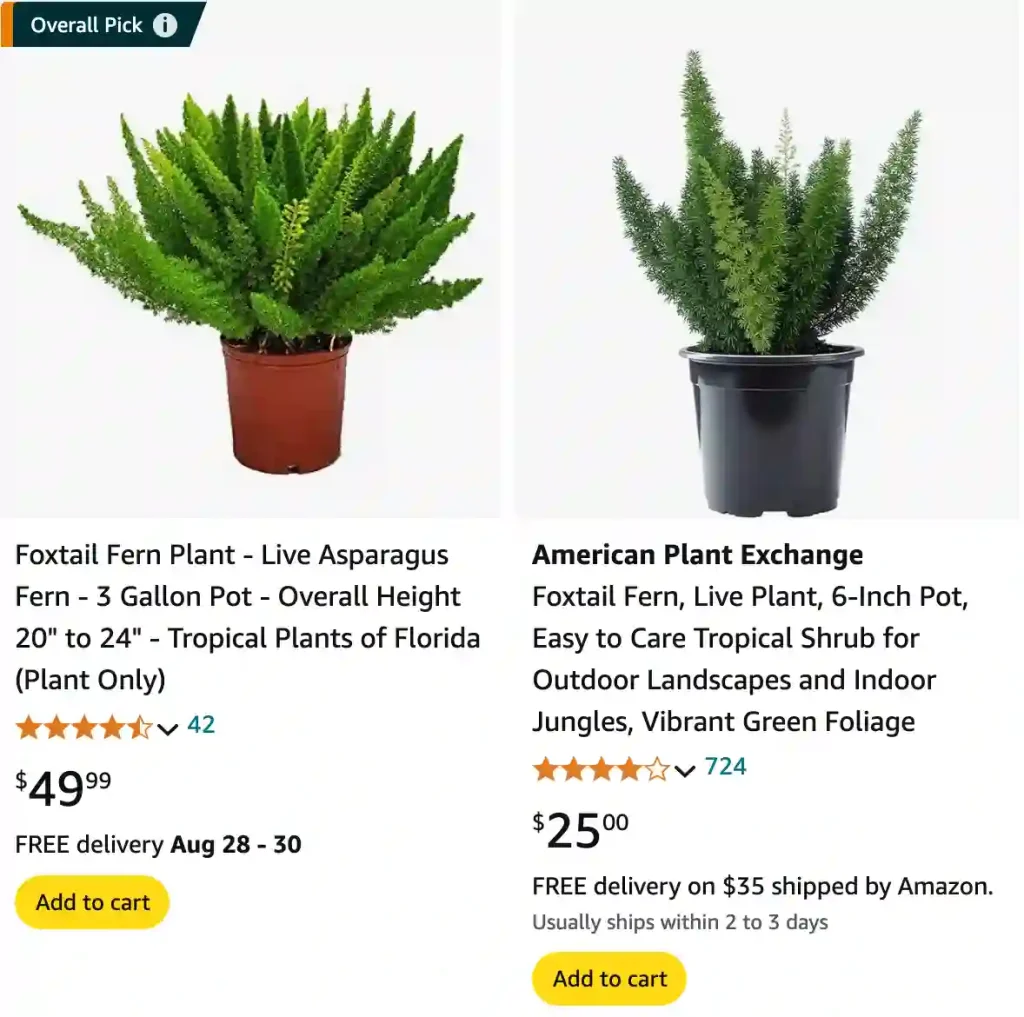
Frequently Asked Questions About Foxtail Ferns
As a plant enthusiast, I’ve found Foxtail Ferns to be both captivating and a bit puzzling. Their unique appearance and care needs can spark a lot of questions. Here’s a detailed guide based on my experiences and research.
210 Species in Genus Asparagus
What is Foxtail Fern?
Foxtail Fern (Asparagus Densiflorus) is an evergreen perennial known for its lush, feathery foliage that resembles a fox’s tail. Despite its common name, it is not a true fern. This plant belongs to the Asparagus family and is prized for its ornamental qualities.
Is Foxtail Fern Poisonous to Humans?
One question I often encounter is whether Foxtail Fern is poisonous to humans. Fortunately, it is not considered toxic. While it is always wise to avoid ingesting any plant material, Foxtail Fern is relatively safe around people.
Is Foxtail Fern Poisonous to Dogs?
If you have pets, you might be concerned about their safety around Foxtail Fern. The good news is that Foxtail Fern is also not known to be toxic to dogs. Nevertheless, it’s a good idea to monitor your pets to ensure they don’t chew on or ingest any plant material, as this can sometimes lead to digestive issues.
How to Care for Foxtail Fern in Winter?
Caring for Foxtail Fern in winter can be a bit tricky. This plant thrives in warmer climates and prefers temperatures between 60-75°F (15-24°C). During winter, it’s crucial to protect it from frost. If you’re growing it outdoors in a cooler climate, consider moving it to a sheltered location or bringing it indoors. Keep the soil consistently moist but not waterlogged, and reduce fertilization during the colder months.
How to Propagate Foxtail Fern?
Propagating Foxtail Fern can be quite rewarding. The most common method is through division. Here’s how I do it:
- Timing: Early spring is the best time for propagation.
- Division: Gently remove the plant from its pot and divide the root ball into smaller sections. Each section should have a healthy portion of roots and foliage.
- Re-potting: Plant each section in its own pot with fresh potting mix. Ensure the new pots have good drainage.
- Care: Water the newly potted sections well and place them in a location with bright, indirect light.
How Big Do Foxtail Ferns Get?
Foxtail Ferns typically grow to about 1 to 3 feet in height and width. They are relatively compact, making them suitable for container gardening or as a decorative indoor plant.
Is Foxtail Fern a Perennial?
Yes, Foxtail Fern is a perennial plant. It can thrive year after year with proper care, which makes it a great choice for long-term garden beds or indoor arrangements.
Can Foxtail Ferns Take Full Sun?
Foxtail Ferns prefer bright, indirect light. While they can tolerate some direct sunlight, especially in the morning, they don’t do well in full sun. Too much direct sunlight can scorch their delicate fronds. For the best results, provide them with filtered light or place them in a location with morning sun and afternoon shade.
Where to Buy Foxtail Fern Near Me?
Finding Foxtail Ferns can be quite easy if you know where to look. Check local garden centers, nurseries, or plant shops. Many also offer online purchasing options. Local botanical gardens or plant fairs can be excellent places to find unique varieties of Foxtail Fern.
Do Deer Eat Foxtail Fern?
If you have a deer problem, Foxtail Fern can be a good choice for your garden. Generally, deer tend to avoid Foxtail Ferns because of their tough, prickly texture. However, in times of extreme hunger, deer might nibble on almost anything, so it’s not entirely deer-proof.
Foxtail Fern vs Asparagus Fern
A common point of confusion is the difference between Foxtail Fern and Asparagus Fern. While Foxtail Fern is a specific type of Asparagus Fern, not all Asparagus Ferns have the same appearance. Foxtail Fern is known for its dense, upright foliage that resembles a fox’s tail, whereas other types of Asparagus Ferns might have a more sprawling growth habit.
Benefits of Foxtail Fern
Foxtail Ferns are not just decorative; they offer several benefits:
- Low Maintenance: They are relatively easy to care for, needing only moderate watering and indirect light.
- Versatile: Suitable for indoor or outdoor settings and can be grown in containers or garden beds.
- Air Purification: Like many houseplants, Foxtail Ferns can help improve indoor air quality by filtering pollutants.
Common Problems with Foxtail Fern
While Foxtail Ferns are generally hardy, they can encounter some issues:
- Yellowing Leaves: This can indicate overwatering or poor drainage.
- Pest Infestations: Watch out for scale insects or spider mites, which can occasionally infest the plant.
- Fungal Issues: Ensure good air circulation to prevent fungal diseases, especially in humid conditions.
In summary, Foxtail Ferns are a charming and versatile plant that can brighten up any space. By understanding their care requirements and potential issues, you can enjoy their beauty and benefits for years to come.
If i die, water my plants!



